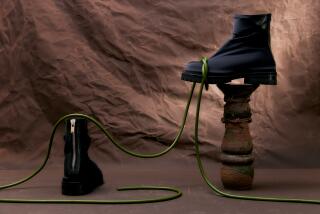Dress down, power up
- Share via
PARIS gave the fashion world the little black dress, Milan the perfectly tailored jacket. And Los Angeles? The Juicy Couture tracksuit. That’s right, thanks to Southern California, sweats aren’t just for the gym, jeans aren’t just for weekends and flip-flops aren’t just for the beach.
That’s because Southern California made casual chic. Sure, our relaxed aesthetic has had its low points: aerobics gear at the mall, baseball caps at the public viewing of a fallen president. But in this land of leisure, where the ideal (if rarely the practice) is that you can surf and ski on the same day and Hollywood is forever in the spotlight, formality doesn’t always cut it.
In the 1920s, around the time Coco Chanel made it fashionable to have a suntan, Southern California became a destination for summer vacationers. They traveled west to enjoy the temperate weather, ditching their European-inspired designer clothes for versatile, lightweight casual wear. In the 1930s, Lou Van Roy introduced the idea of sportswear separates, creating casual pantsuits, culottes and playsuits. Cole of California designed bathing suits with matching skirts in the 1940s to enable a smooth transition from poolside to dining room.
Fashion designer Rudi Gernreich liberated women from structured bodices and put them in knit separates in the 1960s, proving that sporty and sophisticated could go together. The same principle applies to the Juicy Couture tracksuit (designed to flatter a woman’s curves enough to take her from yoga class to lunch at the Ivy), as well as today’s multi-functional knit pieces from such L.A.-based brands as Three Dots, Ella Moss and C&C — pull-on skirts, kimono-shaped dresses and tie-front tops.
Southern California’s beach and mountain playground has bred a generation of weekend warriors and billion-dollar action sports brands to dress them. The Huntington Beach-”Fast Times at Ridgemont High” aesthetic has even turned up on the Chanel runway in Paris. And kids from Iowa who’ve never seen the ocean can buy into the lifestyle with Quiksilver board shorts and Reef flip-flops.
The inherently California desire to conquer the outdoors (or at least to dress like it) might be a holdover from the frontier era, or from the days kids spent watching heroes Davy Crockett and Daniel Boone on TV in their coonskin caps. Hollywood took the Western look mainstream, but the rhinestone-studded snap-front shirts, jackets and chaps worn by Roy Rogers, Gram Parsons and Elvis Presley were worlds away from what was worn on the ranch. These weren’t ordinary cowboys, they were showmen, outfitted by San Fernando Valley-based Nudie Cohn and other rodeo tailors, whose brand of cowboy cool has never gone out of style.
Levi’s was born out of the rugged frontier image too, in Northern California. Yet Southern California brands like True Religion, 7 for All Mankind and Frankie B. gave denim enough refinement to go out to dinner, dropping the waists for a sexy, body-conscious fit. Los Angeles-based Tom Ford added beads and feathers to the cuffs, elevating jeans to the realm of luxury fashion.
Today, the more money and influence you have, the more you can afford to dress down. That’s why Bill Gates conducts business in a button-down shirt and khakis. And why Sharon Stone showed up at the Oscars in 1996 in a Gap turtleneck and a Valentino ball skirt.
For all the ink spilled about the red carpet, the rest of the world connects with how celebrities go casual. Whether it’s Marlon Brando’s T-shirt and leather motorcycle jacket, the full-cut pants Katharine Hepburn and Lauren Bacall popularized or the Ugg boots, short shorts and bug-eyed sunglasses Nicole Richie wears to shop on Robertson Boulevard, people have an insatiable interest in copying what celebrities wear.
After all, who can afford the $15,000 backless gown Hilary Swank wore to the Golden Globes? And where would you wear it in a world where casual is king?
booth.moore@latimes.com








